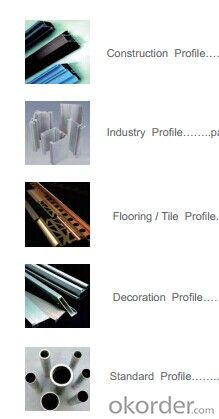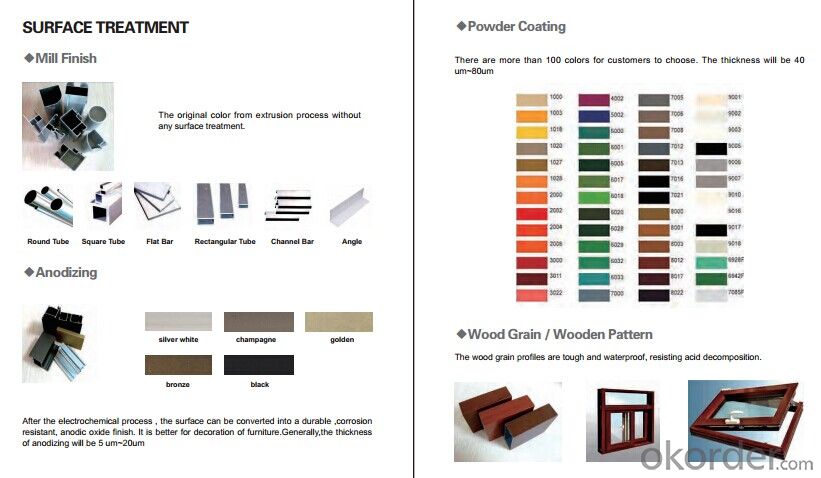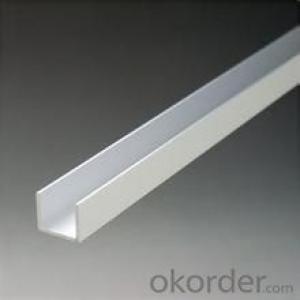Aluminum profile Section H cable tray
- Loading Port:
- China Main Port
- Payment Terms:
- TT OR LC
- Min Order Qty:
- -
- Supply Capability:
- -
OKorder Service Pledge
OKorder Financial Service
You Might Also Like
Aluminium is a relatively soft,durable, lightweight, ductile and malleablemetal with appearance ranging from silvery to dull gray,depending on the surface roughness. It is nonmagnetic and does not easilyignite. A fresh film of aluminium serves as a good reflector (approximately92%) of visible light and an excellent reflector (as much as98%) of medium and far infrared radiation. The yield strength of pure aluminium is 7–11 MPa,while aluminium alloys have yield strengths ranging from200 MPa to 600 MPa. Aluminium has about one-third the density and stiffnessof steel. It iseasily machined,cast, drawn and extruded.
Alu Profile:
Material | Alloy 6063,6061,6005or according to customer’s choice |
Temper | T3, T4, T5, T6 |
Surface | Anodize, electrophoresis, powder coating, PVDF coating, wood grain painting, matted, etc. |
Length | Coating 6.5 meters, Anodizing 6.5 meters, Mill finish 5 meters |
Application | Industrial, electrical equipment(TV set, air conditioner, refrigerator, computer), decoration,construction, transportation |
Custom Made | We can package following with customer's request. |



FAQ:
1. What is the form of payment?
Normally 30% TT, L/C at sight
2. Type of quotation?
FOB, CFR, CIF
3. Port of loading?
Guangzhou/Shenzhen port
4. Delivery time?
15-20 days after client’s deposit
- Q:How do you select the appropriate aluminum profile for a specific application?
- To select the appropriate aluminum profile for a specific application, one must consider several factors. Firstly, the desired strength and durability of the profile should match the requirements of the application. The profile's dimensions, such as length, width, and thickness, should also be chosen to fit the intended purpose. Additionally, considering the environment in which the profile will be used is essential, as factors like corrosion resistance, temperature resistance, and weight-bearing capacity will impact the selection. Moreover, the specific design features and compatibility with other components or structures should be taken into account. Lastly, considering the cost and availability of the chosen aluminum profile is crucial to ensure it aligns with the project's budget and timeline.
- Q:What are the different methods of joining aluminum profiles together?
- There are several methods for joining aluminum profiles together, including mechanical fastening, welding, adhesive bonding, and thermal joining. Mechanical fastening involves using screws, bolts, or rivets to secure the profiles together. Welding involves melting the aluminum at the joint and fusing the two profiles together. Adhesive bonding involves using high-strength adhesive to bond the profiles together. Thermal joining methods, such as thermal expansion or friction stir welding, use heat and pressure to join the aluminum profiles.
- Q:What are the noise reduction properties of aluminum profiles?
- Aluminum profiles have good noise reduction properties due to their ability to absorb and dampen sound vibrations. The high density and stiffness of aluminum help to minimize noise transmission, making it an effective material for reducing unwanted noise in various applications.
- Q:How do aluminum profiles contribute to water management strategies?
- Due to their inherent properties and versatility, aluminum profiles play a crucial role in water management strategies. They are commonly utilized in the construction of various water management infrastructure, such as pipes, channels, and tanks. To begin with, aluminum profiles possess a combination of lightweight and sturdy characteristics that make them ideal for constructing water pipes. Their lightweight nature allows for easy transportation and installation, while their strength ensures durability and resistance to corrosion. This is particularly important in water management systems, as it minimizes the likelihood of leaks and damages, guaranteeing the efficient and effective transportation of water resources. Furthermore, aluminum profiles exhibit a high level of resistance to corrosion. As corrosion poses a significant threat in water management, as it can contaminate water and cause damage to infrastructure, the utilization of aluminum profiles significantly reduces this risk. Consequently, water quality is improved, and the lifespan of the infrastructure is prolonged. In addition, aluminum profiles offer a high degree of customization and can be fabricated into various shapes and sizes, enabling the creation of efficient water management systems. Channels, culverts, and tanks, which are essential components of water management infrastructure, can be constructed using these versatile profiles. Their flexibility allows engineers and designers to develop efficient and effective systems capable of handling large volumes of water, ensuring proper water management in different scenarios, including irrigation, flood control, and wastewater treatment. Moreover, aluminum is a sustainable material that can be recycled indefinitely without losing its properties. This makes aluminum profiles an environmentally friendly choice, aligning with sustainable water management practices. By adopting aluminum profiles, water management strategies can minimize their environmental impact and contribute to a more sustainable future. Overall, aluminum profiles exert a significant influence on water management strategies. Their lightweight yet sturdy nature, resistance to corrosion, versatility, and sustainability make them indispensable in the construction of water management infrastructure. Through the utilization of these profiles, water management systems can be built to efficiently and effectively handle water resources, reducing the risk of contamination, improving water quality, and promoting sustainability.
- Q:What do you mean by aluminum alloy T3-T8? Someone who answers me, thanks a lot
- Aluminum alloy profile T3 refers to natural aging after solid solution treatment.Aluminum alloy profile T8 refers to solution treatment, cold work, artificial aging.
- Q:How do aluminum profiles perform in terms of weather resistance?
- Aluminum profiles exhibit excellent weather resistance due to their inherent corrosion resistance properties. They are highly resistant to rust, rot, and degradation caused by exposure to various weather conditions like rain, sunlight, and extreme temperature changes. Additionally, aluminum profiles can be further enhanced with protective coatings or finishes to enhance their durability and longevity in outdoor environments.
- Q:What are the different types of corner connectors used with aluminum profiles?
- Aluminum profiles commonly utilize several types of corner connectors for joining. These connectors facilitate the creation of diverse structures like frames, enclosures, and shelving units. One prevalent corner connector is the 90-degree angle bracket. It possesses a right angle shape with holes on each side to accommodate screws or bolts for fastening the profiles together. The 90-degree angle bracket is adaptable and suitable for various applications. Another corner connector is the 45-degree angle bracket, similar to the 90-degree angle bracket but designed for a 45-degree angle joint between profiles. It finds use in applications requiring slanted or angled structures. T-slot corner connectors are also popular. They have a T-shaped slot for easy insertion of profiles. These connectors are ideal for applications that prioritize adjustability and flexibility, allowing for effortless repositioning and modification of the structure. Some corner connectors are specifically designed for particular profile types, such as the end cap connector. This connector caps off the profile's end, providing a polished appearance and protection against damage. Furthermore, various other corner connectors exist, including corner gussets, angle plates, and corner brackets. Each connector type offers unique features and advantages, catering to different applications and requirements. In summary, the assortment of corner connectors available for aluminum profiles offers a wide range of options for joining and assembling structures. These connectors provide strength, stability, and versatility, making them indispensable components in aluminum profile-based construction projects.
- Q:I would like to know where Urumqi has industrial aluminum profiles, such as 3030, 4040, 3060 aluminum, etc., note that industrial aluminum, not doors and windows, aluminum profiles, the difference between the two very large!
- And shares in the east railway station there, the east railway station and then go one Station Road (near the North Main Road) can see.
- Q:Can aluminum profiles be used for agricultural or farming applications?
- Indeed, agricultural or farming applications can make use of aluminum profiles. They possess several advantages that make them appropriate for these purposes. To start with, aluminum is lightweight, making transportation and installation easy. This proves particularly beneficial in agricultural settings where mobility and flexibility are crucial. Moreover, aluminum boasts high resistance to corrosion, making it perfect for use in harsh environments like farms that often encounter moisture, chemicals, and fertilizers. By preventing rust, it ensures durability and longevity, reducing the need for frequent replacements. Additionally, aluminum profiles can be easily customized and fabricated to fulfill specific requirements. This flexibility enables the creation of structures such as greenhouse frames, support beams, shelving systems, and other components essential in agricultural operations. Furthermore, aluminum profiles are non-toxic and do not emit harmful substances into the surrounding environment. This characteristic ensures their safety for use in farming applications, where the well-being of animals and crops is of utmost importance. Lastly, aluminum is a sustainable material that can be recycled indefinitely, minimizing its environmental impact. This aligns with the increasing emphasis on sustainability in agriculture. To conclude, due to their lightweight nature, resistance to corrosion, adaptability, safety, and sustainability, aluminum profiles are indeed suitable for various agricultural and farming applications.
- Q:How do aluminum profiles compare to plastic profiles?
- Aluminum profiles and plastic profiles are commonly used in various industries for different applications. When comparing the two, there are several factors to consider. Strength and Durability: Aluminum profiles are generally stronger and more durable than plastic profiles. Aluminum has high tensile strength, allowing it to withstand heavy loads and resist deformation. Plastic profiles, on the other hand, are more prone to cracking or breaking under excessive stress. Weight: Aluminum profiles are heavier than plastic profiles. This can be an advantage or disadvantage depending on the specific application. Aluminum's weight can provide stability and strength, while plastic's lightweight nature can make it easier to handle and install. Corrosion Resistance: Aluminum profiles have excellent corrosion resistance properties. They can withstand exposure to various environmental conditions, making them suitable for outdoor applications. Plastic profiles, however, are not as resistant to certain chemicals or UV radiation, which can cause degradation over time. Flexibility and Design: Plastic profiles offer more design flexibility compared to aluminum profiles. Plastic can be easily molded into complex shapes and customized according to specific requirements. Aluminum, although less flexible, can still be shaped or extruded into different profiles with some limitations. Thermal and Electrical Conductivity: Aluminum profiles have superior thermal conductivity, allowing them to dissipate heat more effectively. They are often used in applications where heat dissipation is critical, such as electronics or heat sinks. Plastic profiles have lower thermal conductivity and are less suitable for such applications. Cost: Plastic profiles are generally more cost-effective than aluminum profiles. The manufacturing process for plastic profiles is simpler and cheaper, resulting in lower production costs. Aluminum profiles, on the other hand, require more advanced manufacturing techniques and additional finishing processes, making them relatively more expensive. In conclusion, the choice between aluminum and plastic profiles depends on the specific requirements of the application. Aluminum profiles offer superior strength, durability, and corrosion resistance, making them suitable for heavy-duty or outdoor applications. Plastic profiles, on the other hand, provide more design flexibility and cost-effectiveness, making them ideal for lightweight or customized applications.
1. Manufacturer Overview |
|
|---|---|
| Location | |
| Year Established | |
| Annual Output Value | |
| Main Markets | |
| Company Certifications | |
2. Manufacturer Certificates |
|
|---|---|
| a) Certification Name | |
| Range | |
| Reference | |
| Validity Period | |
3. Manufacturer Capability |
|
|---|---|
| a)Trade Capacity | |
| Nearest Port | |
| Export Percentage | |
| No.of Employees in Trade Department | |
| Language Spoken: | |
| b)Factory Information | |
| Factory Size: | |
| No. of Production Lines | |
| Contract Manufacturing | |
| Product Price Range | |
Send your message to us
Aluminum profile Section H cable tray
- Loading Port:
- China Main Port
- Payment Terms:
- TT OR LC
- Min Order Qty:
- -
- Supply Capability:
- -
OKorder Service Pledge
OKorder Financial Service
Similar products
New products
Hot products
Hot Searches
Related keywords





























